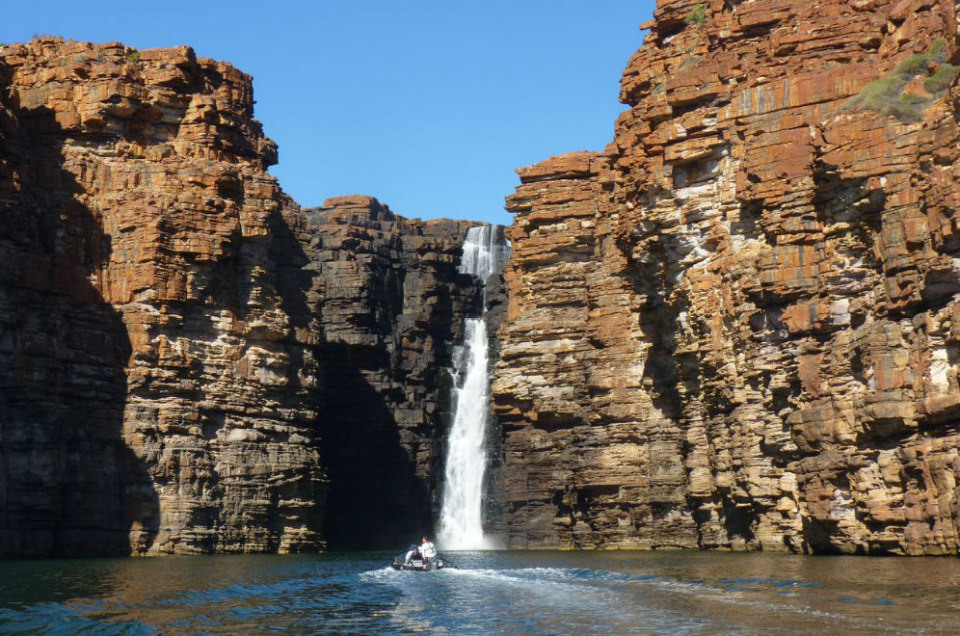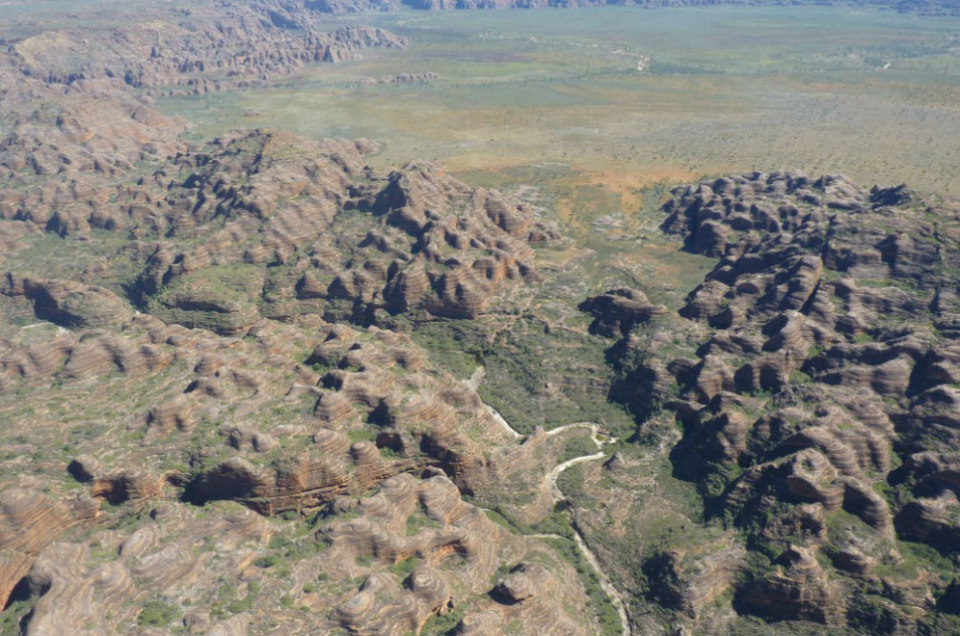There are two things in life that I usually like to be dry: my camera and my champagne.
But when I had the opportunity to sit under the thundering roar of King George Falls in Western Australia I jumped at the chance to sacrifice my camera and ride a zodiac into the thrashing waterfall. Water surged over the jagged sandstone cliffs and pounded my head until I emerged, exhilarated and soaking wet, to be greeted by a glass of (dry, of course) champagne from our cruise ship staff.
Chilled bubbly was just what I needed after a hot hike scrambling up rocks to reach the top of the twin falls. There we’d taken a dip in the pools and looked down on the russet gorge below where ospreys swooped, fruit bats hung in ancient sandstone coves and skittish rock wallabies hid from the saltwater crocodiles.
Miles from anywhere – including our 100-passenger luxury ship Orion – post-hike cocktails were not what I’d expected on an expedition cruise from Darwin to Broome along the remote coast of The Kimberley in Western Australia.
But it was always a pleasant surprise when maître d’ Clinton unexpectedly turned up, like a rare species of wildlife, with his blue Orion flag and champagne. Lesser-spotted Clinton could be found in the most unusual places – under waterfalls, moored near crocodile-infested beaches or appearing on sand spits in the middle of the sea.
Clinton was part of Australian cruise line Orion’s team that looked after us during 11 days onboard; serving us gourmet food dreamt up by top Aussie chef Serge Dansereau and bringing us canapés while we had a daily briefing in the comfy lounge. Some evenings we ate outside under the stars and after a successful trip on Orion’s fishing boat one passenger achieved instant celebrity by donating a huge Spanish mackerel for the barbecue.
We began the cruise with two days at sea heading to East Timor for an operational stop, which gave us the chance to enjoy a dip in the pool or relax on deck. Our first destination was Wyndham, the northernmost town in Western Australia. From this dusty frontier town we took to the skies on a flightseeing trip across The Kimberley to the Bungle Bungles. Below the small plane the earth was surprisingly green for the dry season, with red grazes of jagged rocks jutting up like a crocodile’s spine. Dry rivers snaked across the wilderness, with the occasional dirt road scarring the cracked land and chubby boab trees pocking the ridges.
Passing the Pentecostal Ranges, featured in Baz Lurhmanns’s film Australia as Faraway Land homestead, we reached the remote Bungle Bungles. These giant beehives made of sandstone were only ‘discovered’ in the 80s by a film crew scouting for locations. We discovered a few colorful surprises ourselves as we flew over the vast blue oasis of Lake Argyle and the gaping wound of Argyle Diamond Mine, where rare pink diamonds are found.
The huge Kimberley region – which is a third larger than the UK – was strategically important during WW2 as the cities of Darwin and Broome were crucial military bases close to Asia. At Vansittart Bay we visited the wreckage of a C53 bomber that had crash-landed in 1942 whilst evacuating people from Java. All survived the crash, but the mangled remains of the airplane still glint in the sun amongst the pandanus and boab trees, looking like a scene from Lost.
At nearby Jar Island Macassans from Indonesia came to collect sea cucumbers in the 18th century and left pottery behind – giving the island its name. Here we scrambled up rocks to discover the Gwion (bird) art gallery where aboriginal people believed birds pecked the rocks until they bled to create the long thin painted human figures. They’ve since been named ‘Bradshaw’ art after the first European to record this style of painting in 1891 and mystery surrounds the origin of the paintings – a wasps’ nest covering one was carbon-dated to be more than 17,000 years old.
Later in the trip we experienced different aboriginal art at Raft Point, where the cave sat high on a plateau surrounded by Kimberley rose trees and swooping Brahaminy kites, and the climb took us from the shell-strewn beach past bulbous boab trees to the ‘art gallery’. Native Worrora people had painted haunting images of Wandjinas here – these ancestral beings have giant haloed heads representing rain clouds. White ochre was used to paint the fish, rain gods and animals that adorn the cave walls and when moisture gets into the sandstone it creates an eerie glow.
Just 10 nautical miles from the art site was Montgomery Reef, where the ancient Worrora would catch food at low tide. As we waited in the zodiacs the reef appeared to rise out of the water as the tide dropped – revealing flapping sharks caught on the coral and giant green turtles popping their heads up to gasp for air. Plumes of sea gushed like a waterfall off the reef and on our way back to the ship there was an even more amazing sight to behold – a sand spit had emerged from the sea and on it was Clinton with his blue umbrella. ‘Welcome MV Orion’ had been etched in the sand and the team was on hand to pass out rum cocktails for us to enjoy in the egg-yolk yellow sunset as we zipped back on our zodiacs.
At Talbot Bay the geological mash ups from the Kimberley slamming into mainland Australia 1800m years ago can still be seen amongst the jagged rocks and layers of sandstone. Termite mounds line the cliffs like grey tombstones and the protected bays are home to humpback whales later in the year – towards the end of the trip as we headed out to the Lacepede Islands we came across a mother and calve who had got lost and were happy to follow the ship. The Kimberley region has a massive tidal range. At Talbot Bay’s rushing horizontal waterfalls up to three times the volume of water in Sydney Harbor is pushed through a small gap in the rocks. It creates whirling, crashing waves, which we bounced through in the zodiacs at low tide.
Due to the trip being an expedition we never knew exactly what was in store for us each day and there were often different experiences on the morning and afternoon zodiac cruises; depending on the tide levels. At Hunter River a morning trip into the extensive mangrove at high tide meant we could reach the mouth of the river past craggy black and red blusters – by low tide the salty mangroves were sticking up out of the mud and our earlier route had been cut off. Leaving Orion on the zodiacs we entered the long, winding waterway and passed craggy coastline that gave way to a small bay where a crocodile had bagged the best position; spread-eagled on the sand as a white bellied sea eagle hovered overhead.
We passed the lazy reptile again on our way back to the ship, but this time there was noisy chatter as we reached for our binoculars. Sleepy croc had a new neighbor – our smiling maître d’ with his blue umbrella and armfuls of ice creams. Now that’s the kind of wildlife I like to see.

